|
ANZA-BORREGO DESERT WILDLIFE
Bobcat photo by Daren Sefcik:
Daren writes: Ever get that feeling you are being watched? I was out in
the middle of nowhere eating my lunch and I look over and see this bobcat
fixated on me. He watched me for at least 20 minutes before I moved on. I did
not see him move an inch, just stared at me
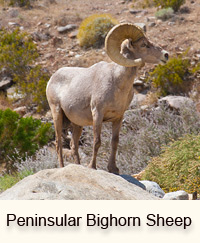
View
2012 Anza-Borrego Sheep Count Results |
The peninsular
bighorn sheep is at the top of the "want-to-see" list of many
Anza-Borrego visitors. Listed as a federally endangered species in
1998, this species is found in several parts of Anza-Borrego and the
Santa Rosa mountains to the north. Peninsular bighorns prefer dry and
rocky low elevation areas, between 300 and 3500 feet in elevation.
During the summer months desert bighorns are most likely to be seen near
sources of water. Popular watering areas, such as those along Coyote
Creek, are closed to vehicle traffic from June until October to allow the
sheep access to water without disturbance. During the rest of
the year, they may be spotted at various locations in Anza-Borrego Desert
State Park. An excellent place to look is along the
Palm Canyon Trail,
at the western edge of Borrego Springs. For the past
42 years, a count of Anza-Borrego's sheep has taken place over the fourth of
July weekend, utilizing volunteers positioned at watering sites, to count
the number of sheep coming to drink. It's a tough assignment, hiking
in to a remote location in mid-summer with temperatures that can reach 115
degrees. But the annual sheep count plays an important role in monitoring
the health of Anza-Borrego's bighorn population. |
|
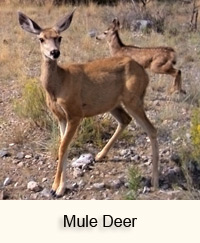 |
Mule deer
are a commonly-seen large mammal in the higher elevations of the park.
Mule deer prefer
to browse on woody vegetation and leafed plants when they are available, and
generally stay in areas that are not far from sources of water.
Deer do most of their foraging around dawn and dusk and are
most likely to be seen in the open at these times. During the main
part of the day mule deer will generally bed down in secluded locations not
far from their foraging areas.
Mountain lions are the primary natural predator
of adult mule deer but bobcats and coyotes may prey upon young or unhealthy
animals. |
|
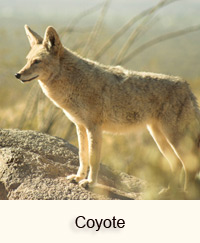 |
The nighttime
yipping and yelping of coyotes is a common sound throughout
Anza-Borrego and coyotes are frequently seen, both traversing the open
desert and walking through residential areas.
Coyotes are the ultimate survivors, found in virtually all environments and
urban settings across North America. Native Americans often portrayed
the coyote as cunning and intelligent, and they live up to this image by
their adaptability, able to survive with whatever food their environment
provides for them. They are opportunistic feeders, and their diet will
include small mammals, birds, snakes, lizards, carrion, fruit, vegetation,
domestic animals and small pets, and larger animals if they are impaired or
unprotected.
Coyotes are very social animals, and the basic structure
is the family group, a female with cubs, an adult male, and perhaps some
adolescent animals. The range of sounds that they make, high pitched
and varied, are to call the group together and to communicate their
position.
Coyotes do not hunt in packs like wolves but they do often
will hunt in pairs. In situations where they
encounter humans on a regular basis they will loose their fear of humans and
pay little attention. But dependence on humans is not something to be
encouraged, and as fascinating as they may be, it is never a good idea to
put food out for the coyotes. |
|
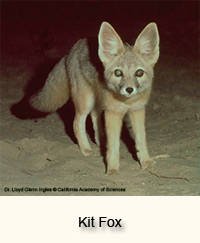
Kit foxes are often seen in the headlights, crossing the road
as you drive through the desert. |
The desert kit fox is the
smallest member of the canidae family found in North America and common in the open desert,
living in the creosote covered alluvial
fans and the sandy washes of Anza-Borrego, where vegetation is sparse. These
foxes are mostly nocturnal, spending the hot part of the day in
the underground dens.
When you see a kit fox for the first time the thing that may seem most
striking is the size of their ears. The oversize ears not only help
with hearing but are also an adaptation to assist with cooling. The
desert adaptations do not stop there; these foxes have a digestive system
that gets most of the water they need from the food that they eat.
They rarely need to drink water.
Kit foxes feed primarily feed
on rodents, rabbits, ground birds, insects, snakes, and lizards.
Kit foxes are not nearly as vocal as coyotes, but they will bark to
communicate with pups or when they feel that their den is threatened. |
|
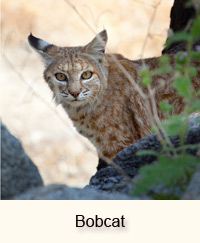
. |
Although there is a good population of bobcats throughout
Anza-Borrego, their solitary, stealthy, and mostly nocturnal nature means
they are not frequently seen. The average adult bobcat is roughly twice the
size of an adult domestic cat. Like
the coyote, bobcats are very adaptable creatures and vary their diet and
hunting style to take advantage of whatever the local environment provides.
Bobcats are exceptional hunters, slowly
approaching their prey with great patience, and then making the kill with a
final powerful leap. Their preferred prey consists of cottontails and
jack-rabbits, rodents, birds, and insects but they are capable of taking
animals as large as deer, particularly if they are weakened or young.
This photo of an Anza-Borrego bobcat was taken by Jason Rothmeyer, who just
happened to have the camera ready when this cat took a look as it was
passing by |
|
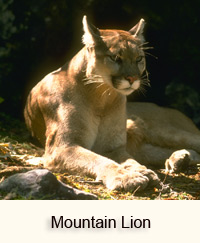
More Information:
UC Davis Veterinary Medicine
Mountain Lion Project |
Mountain lions feed
primarily on deer and they can be found wherever there are healthy deer
populations. In Anza-Borrego, mountain lions also feed on bighorn
sheep, and there are many documented cases of sheep kills in the park. The
UC Davis Veterinary Medicine program has sponsored a mountain lion project
in southern California since 2001, capturing lions using road-killed deer as
bait, and then releasing them with radio collars to track their movements.
These large cats can have very large hunting territories; one
Anza-Borrego cat roamed an area that extended from the mountains south of
Palm Springs to south of the Mexican border.
Mountain lions are extremely secretive in their movements and normally
have an natural aversion to humans. They rarely disclose their
position. But if you do see one in the wild, with males
weighing up to 150 pounds, you are best to follow the advice of the Mountain
Lion Federation: "If you see a mountain lion, no matter how thrilled you are
to be one of the very few gets such an opportunity, stay well back, and take
the encounter seriously." |
|
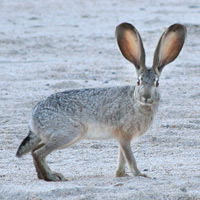 |
The black-tailed jackrabbit is
common throughout Anza-Borrego, particularly in the flat scrub desert, and is easily distinguished from the desert
cottontail by its long ears and long back legs.
Shrubs, trees grasses, and other vegetation are their preferred foods.
Like many desert animals, the black-tailed jackrabbit gets most of the water
it needs from the plants that make up it's diet.
Jackrabbits spend the hot part of the day resting and keeping cool in
shallowed-out depressions in the sand. Like cottontails, when trying
to escape from a threat, the jackrabbit can run at high speed, up to 30 mph
and run in a zig zag pattern.
It's natural enemies are the same as many of the small mammals found on
this page, coyotes, foxes, bobcats, hawks, owls, and snakes. |
|
 |
The desert cottontail is most
active in the morning and late afternoon, and is a common sight around
Borrego Springs, often feeding in large groups as the sun is going down.
Food consists of grasses and other vegetation, and these rabbits rarely need
to drink water, obtaining most of what they need from the foods that they
eat. Like most other rabbits and hares, desert cottontails eat their
feces, giving their bodies a second chance to glean the maximum nutrition
out of the plant materials that they consume.
The desert cottontail has many predators in Anza-Borrego, including
coyotes, bobcats, birds of prey, and snakes. |
|
 |
The antelope squirrel is one of
the few animals that is active during the hottest part of the day.
They are frequently seen scurrying from bush to bush with their tail held
high over their back. Antelope squirrels can tolerate body
temperatures up to 108 degrees, the highest of all mammals. When they
do need to cool off they will stretch out, belly pushed flat on the ground
in some shady spot with legs extended, to cool as much of their surface area
as possible.
Diet consists of seeds, cactus fruits, other vegetation, and insects. |
|
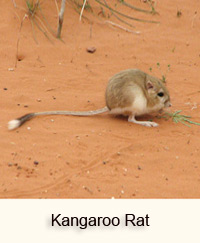 |
With powerful and large back legs,
the tiny kangaroo rat gets its name from the way it moves around; they hop
like a kangaroo, up to six feet in one jump.
This tiny rodent has adapted perfectly to live in a dry desert
environment. Kangaroo rats do not need to ever drink water: they metabolize
water from the dry seeds and other foods that they eat.
The kangaroo rat has a complex system of burrowing; the burrow not only
provides a place to hide from predators and the heat of the desert sun, but
also has different chambers for caching food, sleeping, and living.
|
|
|

